In Depth: Semi-Automatic Espresso Makers
Brewing exceptional espresso requires a mixture of art and science enabled by user control and mechanical reliability. Semi-automatic espresso makers offer the perfect combination of both art and science. A semi-automatic's electric pump eliminates human inconsistency while its free standing portafilter allow the user the opportunity to grind, tamp, and brew espresso as their palate sees fit. With a semi-automatic machine you, the barista, are in charge of your espresso. You may make a few bad cups; you may make a few exceptional cups. Perfecting your technique with semi-automatic espresso makers is half the fun. Enjoying your very own brew is pure bliss!
Types of Semi-Automatic Espresso Makers
As discussed in the article Varieties of Espresso Makers, all types of semi-automatics benefit from an automated pump which insures delivery of water at the right pressure. This feature aids your quest to produce excellent espresso and leaves you with the important but manageable task of grinding and tamping the coffee beans. While all semi-automatic espresso makers contain essentially the same components, there are types that are designed for home-use, commercial use, and home-use/light commercial use.
Consumer and Home Use
Just as quickly as semi-automatic espresso maker's use spread in restaurants and cafes after its invention in the 1940's, demand also grew for a similar product amongst home espresso connoisseurs around the globe. Manufacturers capitalized on this demand and created a slightly smaller machine which is classified for home use based on its portafilter. Because the grinding and tamping of the coffee is a key element with the semi-automatic makers, portafilters (responsible for holding the coffee before brewing) greatly impact the quality of the brew. Home use semi-automatic espresso makers use one of three portafilters:
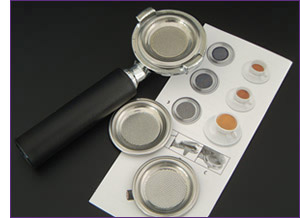 Pressurized
Pressurized- Capsule
- Pod
Pressurized portafilters are great additions to home use semi-automatic espresso makers because of their design. A specially engineered filter basket prevents water flow out of the portafilter until the correct pressure develops. This special feature gives you a little breathing room when it comes to your coffee grinding and tamping skills. Pressurized portafilters are also more accommodating to pre-ground coffees. Capsule portafilters are designed specifically to hold single serving pre-packaged coffees as are Pod portafilters.
Commercial Semi-Automatic Espresso Makers
Commercial semi-automatic espresso makers differ from home-use automatics in that they are larger, sturdier, and use a different size portafilter. These portafilters posses a 58mm diameter which is larger than home-use machines whose portafilters fall into the range of 49 to 54mm. In addition, commercial portafilters are extremely sensitive to the grind of the coffee and tamping pressure which must be just right in order to produce the correct resistance when the water flows through the device.
Prosumer Espresso Makers: Commercial Style Semi's For Home Use
A semi-automatic espresso maker designed for both home use and light commercial use is referred to as a Prosumer espresso maker. Prosumer espresso makers are larger than typical home-use semi-automatics and contain a heat exchange boiler which enables its user to brew, froth, and steam simultaneously. Heat exchange boilers pull water from different portions of the espresso maker's boiler freeing up space to both brew and froth. Prosumer espresso makers require a commercial style portafilter made with chrome-plated brass. While weighty, the chrome plated brass portafilters provide temperature stability which contributes to the quality of the espresso brew.
Getting the Most Out of Your Semi-Automatic Espresso Maker
.jpg) Now that you are an expert in all things semi-automatic, the time is right to discuss ways of maximizing efficiency of your chosen semi-automatic espresso maker. Imagine you have done all the research (wow, the BeverageFactory.com sure has an amazing breath of information on super-automatics!). You've asked yourself all the appropriate questions which explore your deep-seeded desire for owning an espresso machine (yeah I love espresso, but will I use the thing?). Finally, after much soul searching, the truest yearnings of your heart (and taste buds) are too strong to deny (must have semi-automatic espresso machine for home use). Now imagine the doorbell rings, your machine has been delivered. Carefully and quickly you tare open the box to discover a shinning, beautiful machine but you can't help and wonder, now what?
Now that you are an expert in all things semi-automatic, the time is right to discuss ways of maximizing efficiency of your chosen semi-automatic espresso maker. Imagine you have done all the research (wow, the BeverageFactory.com sure has an amazing breath of information on super-automatics!). You've asked yourself all the appropriate questions which explore your deep-seeded desire for owning an espresso machine (yeah I love espresso, but will I use the thing?). Finally, after much soul searching, the truest yearnings of your heart (and taste buds) are too strong to deny (must have semi-automatic espresso machine for home use). Now imagine the doorbell rings, your machine has been delivered. Carefully and quickly you tare open the box to discover a shinning, beautiful machine but you can't help and wonder, now what?
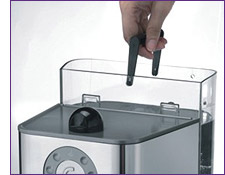 Priming
Priming
Well, first thing is first. Before you can enjoy your very own espresso, you need to prime it. Priming involves pulling water from the reservoir into a dry or empty boiler. This process only takes a few minutes and simply requires you fill the reservoir with water, flipping a few switches, and turning a knob. Your machine will come with detailed instructions but the process is extremely simple and is a recommended step with home-use semi-automatic espresso makers to insure that the boiler is completely full before use. Thanks to their heat exchange boilers, Prosumer espresso makers do not require this step.
You may also prime the machine by pulling a blank shot which involves running the machine as you would with espresso sans the espresso. In addition to accomplishing priming, running a blank shot also speeds up the time it takes the machine to heat up. This may run anywhere from 1 to 5 minutes for small home-use machines to 10-20 minutes for Prosumer or commercial machines. The warming up process heats the water to the temperature necessary for brewing espresso as well as heats the external components such as the portafilter which contributes to the quality of the brew.
Coffee and Water: Keys to a Successful Brewing with Semi-Automatics
Now that your semi-automatic espresso maker has been primed and heated, it is ready to brew! All that is needed are the two ingredients that make up espresso: ground coffee and water. Seems simple enough you may be thinking, however the type and quality of coffee you choose as well as the type of water you put into your espresso machine are two of the most important factors when it comes to producing a deliciously palatable brew.
Coffee
You may choose from four different types of coffee for brewing in your semi-automatic espresso maker: fresh ground, pre-ground, pods, and capsules. As their name implies, fresh ground and pre-ground are both ground coffees. While packaged pre-ground coffee works well with a pressurized portafilter found in most home-use espresso makers, the grind tends to be too coarse for commercial style machines and portafilters.
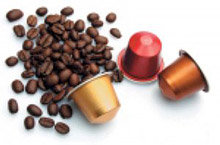 Fresh ground coffee offers the benefit of supreme flavor as well the gratifying ritual of choosing your bean, grinding your coffee to a specific coarseness, and finally enjoying the rich aromas that are truly unique to freshly ground coffee. In addition, using fresh ground coffee in your semi-automatic espresso maker requires you have a grinder handy. With a grinder in your own home, you can insure that you grind your coffee so it appropriately matches the required coarseness of your espresso maker.
Fresh ground coffee offers the benefit of supreme flavor as well the gratifying ritual of choosing your bean, grinding your coffee to a specific coarseness, and finally enjoying the rich aromas that are truly unique to freshly ground coffee. In addition, using fresh ground coffee in your semi-automatic espresso maker requires you have a grinder handy. With a grinder in your own home, you can insure that you grind your coffee so it appropriately matches the required coarseness of your espresso maker.
Your last two coffee options for use in your semi-automatic espresso maker include pods and capsules. Pods are prepackaged single shots of ground espresso and are usually marked ESE (Easy Serving Espresso) which means they can be used with any espresso maker who shares an ESE compatibility. This easy identification system has made ESE pod's the most widely resourced in the industry.
Capsules, like pods, are single pre-packaged shots of espresso which come in a variety of shapes and sizes and are unique to their manufacturer. Because capsules are covered in aluminum or tin, the amount of water flow in the brewing process is greatly reduced due to the limited amount of water that can reach the coffee inside.
While the quality of the brew produced with capsules and pods is not as high as either pre-ground or fresh ground coffee, they do offer convenience and easy clean up and are an example of how important it is to consider the type of coffee you plan on buying before you purchase your espresso machine. For more information regarding purchasing an espresso maker, please visit our exclusive Quick Buying Guide to Espresso Makers.
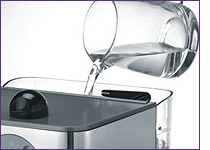 Water
Water
Just as the type of coffee you are planning to use in your semi-automatic espresso maker largely influences the outcome of your espresso, water used in the brewing process is equally responsible for the taste of your brew. While hard waters such as tap and well are the most commonly used and the most tempting to use because of their convenience, they are not always the best. Hard water contains higher quantities of calcium and magnesium than bottled or filtered water and these minerals will deposit in your espresso maker's boiler and tubing eventually restricting water flow.
De-ionized and distilled water affect both the taste of the espresso and can damage the inner workings of semi-automatic espresso makers. The water eventually pits the boiler while the lack of minerals in the water leaves a void in the flavor of the espresso.
Cleaning and Maintaining Semi-Automatic Espresso Makers
To insure optimal brewing quality, semi-automatic espresso makers require day to day cleaning and maintenance. After you enjoy your delicious and delectable espresso drink, it is important to get in the practice of first dumping out the spent grounds from the portafilter and then rinsing the portafilter with water from either the hot water dispenser on a Prosumer machine or the brew group on the home-use machines taking care to rid the portafilter's filter basket of all excess grinds. This helps insure the quality of future brews and prevents clogging.
 The drip tray, the tray that collects unused water for brewing as well as water for rinsing, must be emptied frequently. You will also want to pay close attention to the espresso maker's frothing wand. Due to its frequent contact with milk, it will need to be wiped with a damp rag after use in addition to shooting extra steam out of the wand in order to clear the inside of milk that may have been accumulating.
The drip tray, the tray that collects unused water for brewing as well as water for rinsing, must be emptied frequently. You will also want to pay close attention to the espresso maker's frothing wand. Due to its frequent contact with milk, it will need to be wiped with a damp rag after use in addition to shooting extra steam out of the wand in order to clear the inside of milk that may have been accumulating.
Now that the outside portions of your semi-automatic espresso maker are clean, it is time to turn your intention inwards. Prosumer machines must be back flushed once a week while home-use machines must be decalcified every three to four months.
No matter what type of semi-automatic espresso maker you own, you will want to be sure to frequently soak your shower screen, filter baskets, portafilter, and steam wand to remove clogs and debris. It's also a good idea to scrub those parts which are deposit prone with a group brush.
Is There Anything Else?
Thank you for reading our informative, knowledgeable, and extremely entertaining In Depth Look at Semi-Automatic Espresso Makers. Now that you are practically an expert in all things semi-automatic, you hopefully have a clearer understanding of why semi-automatic espresso makers are truly the perfect combination of user control and mechanical reliability or as we like to think of it: between art and science. Semi-automatics may require some trial and error and some routine maintenance however they allow you to be your own barista in the comfort of your own home and at your own leisure.
Links:
More On Semi-Automatics:
What else is out there?


 Single Faucet Kegerator Beer Dispensers
Single Faucet Kegerator Beer Dispensers Dual Faucet Two Tap Kegerators
Dual Faucet Two Tap Kegerators Triple Faucet Three Tap Kegerators
Triple Faucet Three Tap Kegerators Undercounter Built-In Kegerators
Undercounter Built-In Kegerators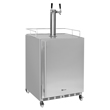 Outdoor Kegerator Beer Dispensers
Outdoor Kegerator Beer Dispensers Commercial Kegerators
Commercial Kegerators Mini Kegerators
Mini Kegerators Cold Brew & Nitro Coffee Dispenser Kegerators
Cold Brew & Nitro Coffee Dispenser Kegerators Home Brew Kegerators
Home Brew Kegerators Carbonated Water Kegerators
Carbonated Water Kegerators 15" Kegerators
15" Kegerators Kombucha Equipment
Kombucha Equipment Guinness® Dispensing Kegerators
Guinness® Dispensing Kegerators Wine Kegerators
Wine Kegerators Kegerator Cabinets
Kegerator Cabinets Kegerator Covers and Accessories
Kegerator Covers and Accessories Kegerators
Kegerators Kegerator Conversion Kits
Kegerator Conversion Kits Kegs & Keg Accessories
Kegs & Keg Accessories Beer Faucets
Beer Faucets Beer Shanks
Beer Shanks Draft Beer Towers
Draft Beer Towers Keg Taps Couplers
Keg Taps Couplers Regulators & Gas Equipment
Regulators & Gas Equipment Beer & Gas Line Hose
Beer & Gas Line Hose Co2 and Nitrogen Air Tanks
Co2 and Nitrogen Air Tanks Beer Line Cleaning Equipment
Beer Line Cleaning Equipment Drip Trays
Drip Trays System Fittings
System Fittings Jockey Boxes
Jockey Boxes Keg Beer Party Pumps
Keg Beer Party Pumps Glassware
Glassware Guinness® Dispensing Equipment
Guinness® Dispensing Equipment Remote Glycol Systems
Remote Glycol Systems Wine Cooler Refrigerators
Wine Cooler Refrigerators Wine Cellar Cabinets
Wine Cellar Cabinets Wine Racks
Wine Racks Cooling Units
Cooling Units Wine Dispensing Systems
Wine Dispensing Systems Wine Accessories
Wine Accessories Wine Making
Wine Making Nitro Hot Draft System
Nitro Hot Draft System Ready to Drink Bag-in-a-Box Coffee Dispensing Equipment
Ready to Drink Bag-in-a-Box Coffee Dispensing Equipment Nitrogen Infusers
Nitrogen Infusers Nitrogen Tanks & Generators
Nitrogen Tanks & Generators Nitrogen Beer Regulators
Nitrogen Beer Regulators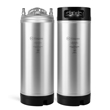 Nitro Cold Brew Coffee Kegs
Nitro Cold Brew Coffee Kegs Cold Brewed Coffee Tools
Cold Brewed Coffee Tools Cleaning Equipment
Cleaning Equipment Outdoor Appliances
Outdoor Appliances ADA Appliances
ADA Appliances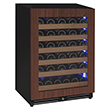 Panel Ready Appliances
Panel Ready Appliances Commercial Grade Appliances
Commercial Grade Appliances Beverage Centers
Beverage Centers Refrigerators
Refrigerators Drawer Refrigerators
Drawer Refrigerators Ice Makers
Ice Makers Water Dispensers & Accessories
Water Dispensers & Accessories Freezers
Freezers Home Brew Equipment Kits
Home Brew Equipment Kits Fermentation Equipment
Fermentation Equipment Boiling and Mashing Equipment
Boiling and Mashing Equipment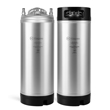 Home Brew Beer Kegs
Home Brew Beer Kegs Home Brew Kegerator Conversion Kits
Home Brew Kegerator Conversion Kits Brewing Tools
Brewing Tools Home Brew Ingredients
Home Brew Ingredients Cleaning Chemicals
Cleaning Chemicals Test Equipment
Test Equipment Home Brew Beer Bottles and Bottling Equipment
Home Brew Beer Bottles and Bottling Equipment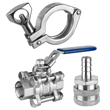 Brewery Fittings
Brewery Fittings Draft Beer Equipment
Draft Beer Equipment Homebrewing Equipment
Homebrewing Equipment Wine Equipment
Wine Equipment Luxury Appliances and Refrigeration
Luxury Appliances and Refrigeration Coffee Equipment
Coffee Equipment Kombucha
Kombucha The Beverage Blog
The Beverage Blog Frequently Asked Beer Questions
Frequently Asked Beer Questions Shop by Brand
Shop by Brand Shop by Category
Shop by Category